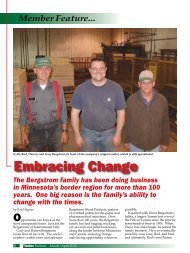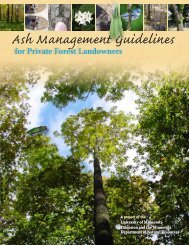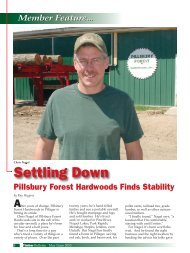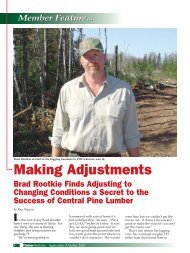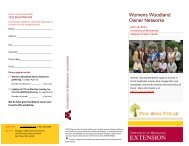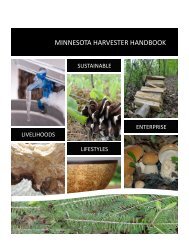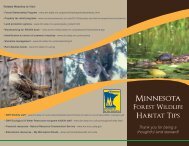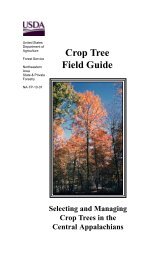Ash Management Guide for Private Forest Landowners
Ash Management Guide for Private Forest Landowners
Ash Management Guide for Private Forest Landowners
You also want an ePaper? Increase the reach of your titles
YUMPU automatically turns print PDFs into web optimized ePapers that Google loves.
and animals need to survive into thefuture. In this <strong>Guide</strong>, the NPC classificationis used as a framework <strong>for</strong> organizingthoughts and facts that concern the ashresource. The classification is used to helplandowners understand why ash treesgrow where they do and to provide guidanceon management strategies.For some Systems, there is much todo; <strong>for</strong> others, there is little that we can do.So, what is a native plant community?A native plant community is a group ofnative plants that interact with each otherand with their environment in ways notgreatly altered by modern human activityor by introduced organisms. These groupsof native plant species <strong>for</strong>m recognizableunits. For instance, if you were walkingthrough a woodland, you might immediatelyidentify that you were walkingthrough an oak savanna, a pine <strong>for</strong>est, ormaybe sloshing through a marsh.Native plant communities are named<strong>for</strong> the characteristic plant species or <strong>for</strong> acharacteristic environmental feature containedwithin them. Examples of nativeplant communities in Minnesota includeDry Barrens Oak Savanna, Red Pine-White Pine <strong>Forest</strong>, Bulrush Marsh, SedgeMeadow, and Mesic Sandstone Cliff. Forpurposes of this <strong>Guide</strong>, you should knowthat ash will potentially be found in one offive native plant communities or systems.Two systems: <strong>Forest</strong> Rich Peatlandsand Fire Dependent typically containminimal ash, but were included in thesurvey so are included here. The five systems,or native plant communities, are:• Wet <strong>Forest</strong> System• Floodplain System• Mesic Hardwood System• <strong>Forest</strong>ed Rich Peatland System• Fire Dependent SystemChapter 5The Native PlantCommunitiesPage 30: Floodplain <strong>Forest</strong>System, Somerset Wildlife<strong>Management</strong> AreaPhoto: Brian Lockhart, USDA <strong>Forest</strong>Service, Bugwood.orgGLOSSARYMesic: Sites or habitatscharacterized by intermediatemoisture conditions.Hydrology and Minnesota Native Plant CommunitiesSoil moisture in <strong>for</strong>est soils is definedby conditions during the summer growingseason. The order from dry to wet in <strong>for</strong>estsdominated by ash or with a significantcomponent of ash is: Fire-Dependent,Mesic Hardwood, Floodplain <strong>Forest</strong>s, Wet<strong>Forest</strong>s, and <strong>Forest</strong>ed Peatlands. Flooplain<strong>Forest</strong>s are, of course, flooded duringthe spring runoff period and occasionallyduring other times; however, in mostyears during the summer months, soilsare less wet than summer soils in the Wet<strong>Forest</strong> system where mucks, peats, clays,and high water tables maintain wet-mesicto wet soil moisture regimes. Floodplain<strong>Forest</strong> soils tend to dry some as the waterlevel in the river drops from flood stage(bankfull) to summer, low flow conditions.The average position of the growing seasonwater table below the soil surface alsodetermines the tree species and herbaceousspecies associated with ash. <strong>Forest</strong>edpeatlands are wet year round becauseof restricted outflow from the peat basin.Peatlands with the highest peatland slopeshave the tallest trees because the downslope movement of water is quickenedand the peat soil is thus better aeratedduring the summer growing season.Photo: MN DNRGreen ash leaflet, showingthe compound leaf31



